HBO's Watchmen Premiere: All The Big References To The Original Comic Book
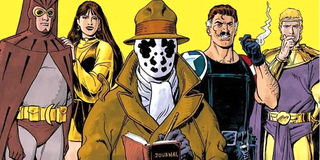
CinemaBlend participates in affiliate programs with various companies. We may earn commission when you click on or make purchases via links.
MAJOR SPOILER WARNING for anyone who hasn’t watched the Watchmen TV show premiere. We get into all the detailed nitty-gritty here.
One of the most revered books out there, comic or otherwise, Alan Moore and Dave Gibbons’ Watchmen is the inspirational touchstone for HBO’s newest TV drama from The Leftovers’ Damon Lindelof. The Watchmen TV show is a current-day sequel to the original tale, though taking place in a different location and centering on mostly different characters. Regardless of the differences, a plethora of comic-friendly references and easter eggs were infused throughout Watchmen’s premiere as plot-setting connective tissue.
Below is a list of all the big Watchmen comic references that showed up in the TV show’s premiere episode, titled “It’s Summer and We’re Running Out of Ice.” From follow-up weirdness to the main story’s shock ending to the appearance of a certain blue superhero, Watchmen was a smorgasbord of “Wait, did you catch that?” moments that deserve quick rewinds. And without further ado, here’s a mostly sequential order of the biggest comic-inspired highlights. (Check here if you need a new copy.)
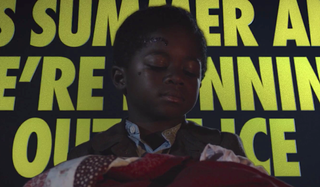
The Blood On The Boy’s Face
Once the orphaned boy wakes up in the field, following that harrowing opening, he has a splotch of blood on his head that definitely feels like a reference to the blood on The Comedian’s button that kicks off Watchmen and serves as one of its most identifiable symbols. This particular reference comes up very obviously at the end of the episode, but it’s worth pointing out that Damon Lindelof also found a way to work a bloodied face into the start of his story. Metaphors abound.
Mirrored Storytelling
The millionth reason Watchmen remains a celebrated and respected work is because Alan Moore and Dave Gibbons were so meticulous about filling the comics with reflected and repeated art, dialogue and situations; examples include Chapter 5’s palindromic nature, Doctor Manhattan’s photograph obsession, the somewhat prescient Black Freighter text and much more.
Beyond all of the Rorschach masks that don’t move, HBO’s Watchmen already made some use of this narrative style in its opening episode. The biggest example, of course, would be the episode starting off with a celebratory film strip of a heroic black man roping up a foul white dude, and then ending with a potentially wicked black man looking very much like he hung a white lawman from a tree. To top it off, the guy in the wheelchair was holding the same note as the kid from the beginning, indicating that this is either a near-impossibly old version of that kid, or perhaps his son. Who’s the hero here?
CINEMABLEND NEWSLETTER
Your Daily Blend of Entertainment News
Electric Cars
Within the alternate world of Alan Moore and Dave Gibbons’ Watchmen, it would appear that all vehicles are powered electrically, with zero reliance on gasoline for fuel. Though the TV premiere doesn’t take viewers into an assortment of planes, trains and automobiles, it looks like the world help steady with electric car power since the main narrative’s timeline, without the need to revert back to cruder forms.
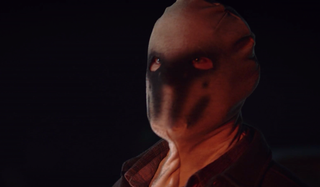
Rorschach Mask And Journal
Yes, this is one of the most obvious entries on this list, and it won’t be the last one. It’s still worth mentioning that the Seventh Kavalry was founded on the basis of Rorschach’s worldview, and the white supremacist cult uses his signature mask as a unifying symbol (and disguise). Is his journal their Bible, or more of a manifesto?
Masks As “Faces”
Throughout Watchmen’s comic story, Rorschach refers to his mask only as his “face,” particularly whenever he gets arrested and has it taken from him. On the Watchmen TV series, Don Johnson’s Judd tells Tim Blake Nelson’s Looking Glass, “Pull your face down,” in reference to the latter slipping his reflective mask back on. It’s interesting that Damon Lindelof has the authorities using that wording, as opposed to only the Seventh Kavalry adopting it.
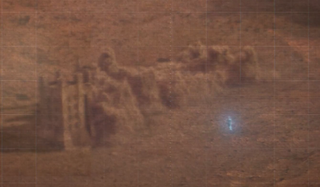
Doctor Manhattan Appears
Watchmen’s mystery-laden build-up kept fans in the dark on how many original characters would appear on the HBO show, and thankfully, the pilot doesn’t get too far before dropping some concrete proof that Doctor Manhattan is still on Mars, and has been for the past 30+ years.
Doctor Manhattan showed up on a news program via satellite footage, in which he could be seen destroying a large and elaborate castle he’d created. (Find out more about that from my interview with director and EP Nicole Kassell.) In general, the situation echoed the blue being’s Mars structure in the comic, although in the TV show, Manhattan’s castle appeared to be a mock-up of the dwelling that Jeremy Irons’ character (almost definitely Adrian Veidt) lives in. Very interesting.
Vietnam, Robert Redford And More
It would have been strange had HBO’s Watchmen changed things up here, but it was confirmed early on that Vietnam is still the 51st state in the U.S., and the American flag represents that with an alternate look. Regina King’s Angela was born outside of Saigon, which is a somewhat deeper connection to the country than the brutal scene in the source material with The Comedian and Doctor Manhattan.
Robert Redford (currently sorta retired in our world) is still the President of the U.S. in Watchmen’s universe after a slew of successive terms, and his predecessor Richard Nixon is part of Mouth Rushmore’s quartet. Redford has his detractors for sure, earning him the name “Sundance-in-Chief.”
Owl Mug
Inside Judd Crawford’s office, Angela can be seen drinking from an owl mug. This is pretty clearly a reference to Watchmen’s Nite Owl, though it doesn’t appear to be actual hero-related merchandise. OR IS IT?!?
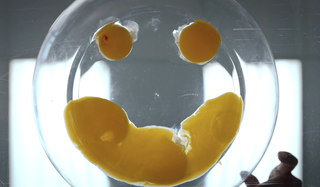
Smiley Faces
As mentioned already, The smiley face button is an iconic symbol within Watchmen’s pages, with The Comedian’s yellow button echoed in a variety of ways. The same goes for HBO’s Watchmen, of course. Beyond a few arguable examples, the most overt visual smiley reference occurred when Regina King’s Angela showed a classroom of kids how to make moon cakes. With the camera below a glass mixing bowl, Angela cracked a bunch of eggs, and after the yolks initially resembled a yellow Rorschach design, they quickly settled into the smiley face layout. Notice that "bloodied eye," too.
Clocks
The Doomsday Clock is another one of Watchmen’s central visual anchors, and the TV show picks up where the comic book left off. Nine times out of ten, if a clock appears on the screen, it’s going to be set between 11:00 and 12:00, in reference to the atomic age catastrophe monitor. In the school, for instance, It looked as if the clock was somewhere around 11:25 a.m. Everyone should be probably be worried when we start seeing times much closer to 12:00.
It’s also no coincidence that the Seventh Kavalry uses adopted a clock’s sounds as its troubling chant: “Tick. Tock. Tick. Tock.” (Though I do wonder why maybe-Veidt’s pocketwatch didn’t follow suit.)
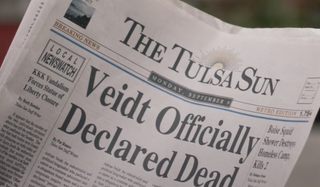
Veidt’s “Death” Notice
Though Jeremy Irons’ character shows up for some oddball moments with Tom Mison and Sara Vickers, viewers aren’t yet privy to what he’s going by on the show. But if he is playing Adrian Veidt, it would appear there is misinformation afoot, as a newspaper headline very clearly states “Veidt Officially Declared Dead.” (Note the Statue of Liberty and squid rain headlines, also.)
Such phrasing implies that Veidt was missing from the public eye for a while before an official declaration was made about his fate, which means he could have been in hiding for the past 10-20 years, depending on the circumstances surrounding his disappearance. Would that have something to do with the anniversary that his servants are celebrating with him?
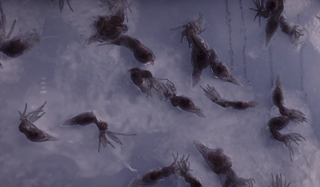
Squids Are Everywhere
Watchmen’s comic book conclusion remains bizarrely surreal all these years later, and Damon Lindelof addresses the Veidt’s squid catastrophe in a big and mysterious way. Though it was one gigantic squid creature that Veidt transported to New York, the TV show’s characters dealt with a temporary rain storm, only with tiny living squids serving as the raindrops.
A squid storms seems like one of the most hilariously disturbing events that could happen in any given day, but Watchmen’s characters are clearly used to it. Angela is quick to get out and wipe the windshield, and there are city cleaning vehicles that were created specifically for removing squids from the streets. But how did things get to this point?
The Minutemen
Within the Watchmen mythos, the first team of vigilante heroes was called the Minutemen, which is with whom The Comedian made a name for himself, both as a hero and as a rapist. (The first versions of Nite Owl and Silk Spectre were also involved.) Much controversy swirled around the various Minutemen members, and within HBO’s Watchmen, those more sordid stories are being showcased through the dramatized TV anthology American Hero Story, a distinctly different AHS than the one airing on FX.
Dirigibles
One of the more curiously unexplained details within Alan Moore and Dave Gibbons’ Watchmen is the pronounced use of skybound dirigibles, often with ads emblazoned. The transportation method made an appearance in HBO’s Watchmen, too, promoting the American Hero Story series.
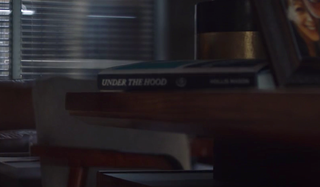
Hollis Mason’s Under The Hood
Also seen in Judd’s office is a copy of Under the Hood, the memoir penned by the first Nite Owl, Hollis Mason. The faux book, whose excerpts were used as supplemental material in the Watchmen comics, was instrumental in inspiring Dan Drieberg to become Nite Owl II, and laid the historical groundwork for the formation and dissolving of the Minutemen.
Within Damon Lindelof’s Watchmen, the term “hood” takes on a completely different meaning, considering the KKK’s involvement. I doubt the TV show will reveal Hollis Mason to be a riotous bigot, but I don’t doubt there are further layers beyond just the visual reference.
Blood Under The Door
This was one of those moments that might not have been a specific Watchmen reference, but the abundance elsewhere convinced me to include it here. Whenever Sister Night beats the crap out of that Nixontown resident for information about the shooter, the extent of the beating is suggested by the possibly bloodied water seeping from beneath the door as she exits.
In the Watchmen source material, a similar situation occurs whenever Dan and Laurie break Rorschach out of prison. The latter enters a restroom to share a few final moments with crime boss Big Figure, whose plans to take Rorschach down failed miserably. The comic did indeed feature water puddling out from beneath the bathroom door, while Zack Snyder’s similarly reference-heavy feature made it very clear that there was blood in the water.
Watch Parts
Seventh Kavalry members were seen taking watches apart in order to get their batteries, which are said to be the old synthetic lithium batteries that got a bunch of people sick. In the first place, watch pieces are a recurring motif within Watchmen’s pages, given Jon Osterman’s family history with watchmaking; the intricate and specific mechanics are indicative of Doctor Manhattan’s mental deconstruction of time and human experiences, as well as his own physical transformation.
I’m curious about the notion that enough people got sick from those batteries that they were eradicated completely. Would that possibly tie into the false narrative Adrian Veidt concocted in the comic about those close to Doctor Manhattan being diagnosed with cancer? Is there a way Veidt, or someone else, found a way to actually make watches kill people?
The Dollar Bill Poster
During the attempted ambush on the Seventh Kavalry’s cattle ranch, Sister Night got into a brawl with one of them in a trailer. The fight was a hectic one, and possibly drew viewers’ attention away from one interesting Watchmen connection. On the wall was a poster for Dollar Bill, the Minutemen hero lauded more for his marketability than his actual skillset.
Dollar Bill came into existence essentially as a bank mascot, but one who could also protect people’s money, even though he inevitably died whenever his cloak got caught in a bank door during a raid. He remained popular, no doubt, but why would Dollar Bill be acknowledged in such a way by the Seventh Kavalry, 70 years after his death? Will HBO’s Watchmen share some big Dollar Bill reveals in Season 1? Do those exist?
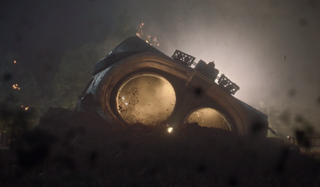
Archie, The Owlship
The only signature form of transport within the Watchmen-verse was Nite Owl II’s Owlship, affectionately called Archie in a reference to Merlin’s pet owl. While there’s no sign of Dan or an actual Nite Owl, the Owlship was used during the cattle ranch mission to try and bring down the Kavalry’s plane. It was being piloted by the character we’ll talk about next, with Judd running point from inside. Considering the mug and Hollis Mason bio, how hard is Watchmen trying to convince us that Judd has some Nite Owl secrets? Or is this possibly just one of many similarly styled vehicles used by police?
Pirate Jenny
Portrayed by All Rise’s Jessica Camacho, the protagonist Pirate Jenny’s main scene was the Owlship sequence, as she was piloting Archie during the chase and crash. That character doesn’t appear within Alan Moore and Dave Gibbons’ Watchmen, but the reference here stems from the use of “pirate” in her codename. As readers know, pirate comics were more popular than superhero comics in Watchmen’s world, given the existence of real superheroes, yet Pirate Jenny is the only big reference to the seafaring criminals.
The Watchmaker’s Son
Jeremy Irons’ maybe-Veidt is talking with two of his servants when he mentions that he’s been working on a tragedy in five acts, which is to be called The Watchmaker’s Son. Such a play doesn’t exist in the source material, but it’s clearly a reference to Doctor Manhattan’s pre-transmogrification days as Jon Osterman. Stay tuned for more on that front, hopefully.
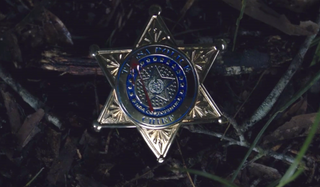
Blood On Judd’s Badge
The end is the beginning is the end in Watchmen world. As it was hinted at in the very beginning of this article, Watchmen is all about reflections and cycles and even, in Damon Lindelof’s hands, a meta-homage to Alan Moore and Dave Gibbons’ twelve-issue masterpiece. In opposition to how the cover and opening panels of “At Midnight, All the Agents…” pull away from the bloodied smiley face button, the premiere TV episode ends by zooming in on Judd’s dropped badge just as a drop of blood splatters across it in an oh-so-familiar way.
The implications of the seemingly well-liked police chief being killed off so early, and so similarly to The Comedian, has a range of potential implications for where Damon Lindelof’s creative team is going to take Judd’s backstory. The foreshadowing makes it pretty clear his family ties are stained with darkness, but I’m all for Don Johnson directly riffing on Edward Blake’s leather and domino mask phases.
The Importance Of Titles
Watchmen’s issue titles were taken from a variety of places, from song lyrics to poetry to Bible verses to Albert Einstein. One’s mileage for interpretations may vary, but there was always a fairly clear reason for why Alan Moore and Dave Gibbons used each title.
For anyone familiar with the musical Oklahoma, or anyone who Googled curiously after the episode titles were revealed, HBO’s Watchmen premiere might have come across as a little spoilery. “It’s Summer and We’re Running Out of Ice” is a lyric from “Pore Jud is Daid,” a song performed in a scene that hypothesizes characters fully appreciating the woeful character Jud only after he hangs himself. Does that mean Judd’s hanging death wasn’t real at the end of the premiere? I actually didn't have that thought until this exact moment, and now I'm invested.
Watchmen is finally here, everybody, and judging by the premiere alone, a whole hell of a lot of work went into making this project both faithful to the source material while also freshening up the central themes and character dynamics. From my perspective as a Watchmen fan, just about every single second of the episode was as engrossing as it could be, and a lot of interesting chess pieces were set atop the board.
With nine episodes set for Season 1, Watchmen airs Sunday nights on HBO at 9 p.m. ET, so be sure to keep up each week before all the mysteries get spoiled.

Nick is a Cajun Country native and an Assistant Managing Editor with a focus on TV and features. His humble origin story with CinemaBlend began all the way back in the pre-streaming era, circa 2009, as a freelancing DVD reviewer and TV recapper. Nick leapfrogged over to the small screen to cover more and more television news and interviews, eventually taking over the section for the current era and covering topics like Yellowstone, The Walking Dead and horror. Born in Louisiana and currently living in Texas — Who Dat Nation over America’s Team all day, all night — Nick spent several years in the hospitality industry, and also worked as a 911 operator. If you ever happened to hear his music or read his comics/short stories, you have his sympathy.
Most Popular






